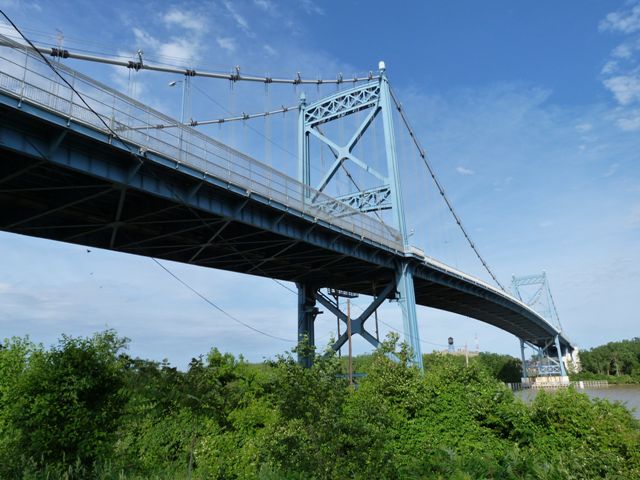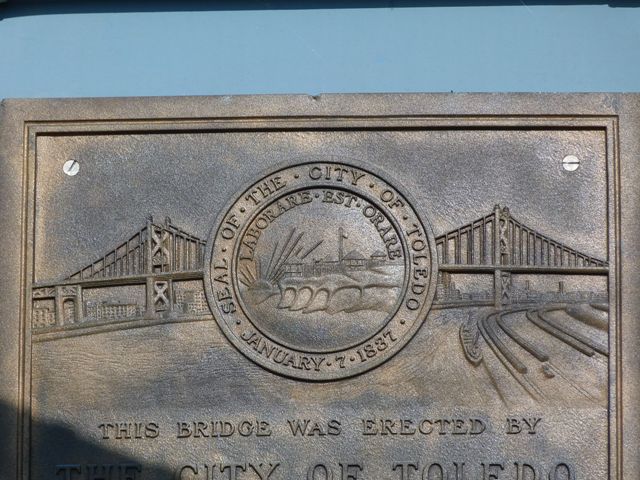We Recommend:
Bach Steel - Experts at historic truss bridge restoration.
Anthony Wayne Bridge
High Level Bridge

Primary Photographer(s): Nathan Holth and Rick McOmber
Bridge Documented: July 4, 2006, June 2, 2011, and September 7, 2015
Toledo: Lucas County, Ohio: United States
Metal Through Plate Girder Stiffening Wire Cable Suspension, Fixed and Approach Spans: Metal Rivet-Connected Warren Deck Truss, Fixed
1931 By Builder/Contractor: McClintic-Marshall Company of Pittsburgh, Pennsylvania and Engineer/Design: Waddell and Hardesty of New York, New York
1961
785.0 Feet (239.3 Meters)
3,215.0 Feet (979.9 Meters)
54 Feet (16.46 Meters)
3 Main Span(s) and 25 Approach Span(s)
4800303

View Information About HSR Ratings
Bridge Documentation
Bridge Status: This historic bridge's deck truss approach spans were demolished and replaced!
Additional Information: As of 2022, this bridge is being listed as an Ohio Historic Civil Engineering Landmark!
View Archived National Bridge Inventory Report - Has Additional Details and Evaluation
The Anthony Wayne Bridge, commonly called simply the High Level Bridge, is Toledo's only historic high level bridge, and it is a defining landmark for the city. Toledo has other Maumee River crossings, some of which are historic, but they are low level crossings with movable spans to provide for navigation.
This impressive bridge was constructed in 1931. The superstructure of this bridge was built by the McClintic-Marshall Company, which is the same company that built the Ambassador Bridge in Detroit. Waddell and Hardesty were consulting engineers for the Anthony Wayne Bridge.
The bridge features an attractive tower design. The towers feature various lattice patterns, and some of the structural steel on them is itself latticed. The top and bottom horizontal portions of the tower bracing above the roadway have a slight arch to them. The towers do not have the extremely tall feeling that some suspension bridges have, because of a medium span length coupled with a wide four-lane roadway on this bridge create the illusion of shorter towers. This is unlike the Fort Steuben Bridge, which is also a medium-length suspension span (actually within a foot of being the exact length of the Anthony Wayne Bridge!), but it has a narrow two-lane deck, so the towers look very tall.

The bridge contains a traditional three design of three suspended spans, one between towers, and one at end end next to the towers. The suspender cables for this bridge extend down from the main cable in pairs. Stiffening for the deck of the Anthony Wayne bridge is accomplished via a through plate girder design. The bridge features a Warren deck truss approach span that is located next to each of the end suspended spans. These approach truss spans feature riveted connections, and v-lacing/lattice. Original decorative sidewalk railings are present on the bridge. The pattern of the railing used on the bridge bears a striking resemblance to a standard railing design used in Michigan and Ontario. The below panoramic photo illustrates the relationship of the suspension spans to the deck truss spans.

This bridge appears to be maintained quite well, which is good to see. The bridge is currently painted a sky blue color. It would be nice to find a more tasteful way to keep people from throwing stuff off the bridge than the current cyclone fence solution. The fencing greatly detracts from the aesthetic value of the structure. The only good thing is that the center span doesn't have the fencing.

ODOT has chosen to rehabilitate the existing historic bridge, rather than demolish and replace Toledo's only monumental-sized historic bridge. The project is slated to begin in 2013. Rehabilitation was the right decision to make, and ODOT deserves to be thanked for making this decision. However, to leave the commentary at that alone without a critical evaluation of the actual scope and method of work in the proposed rehabilitation project for this bridge would be detrimental to other bridge owners who might be exploring what the "best practices" for historic bridge rehabilitation are. The proposed replacement project includes the replacement of significant portions of original bridge material. In particular, the proposed project involves the demolition and replacement the deck truss approach spans with a completely different non-truss structure type, such as pre-stressed concrete box beams. Located directly next to the suspension spans, the deck truss approach spans not only have a major impact on the appearance of the bridge, they are the most historically and technologically significant spans on the bridge aside from the suspended spans. Removal of the deck truss spans will have a dramatic negative effect on the historic integrity of the bridge, reducing the bridge's historic integrity from excellent to perhaps merely fair.
Perhaps the only way it was feasible to continue to have the historic Anthony Wayne Bridge remain a part of Toledo's skyline was to have a rehabilitation with these aggressive alterations. If that truly is the case, than ODOT is right to execute the rehabilitation as proposed. However, a detailed photo-documentation of the bridge conducted in 2011 raises some serious questions as to whether the alterations are needed. The trusses look to be in decent shape. Inspection reports do point to pack rust and section loss, but most of this deterioration appears to be confined to edges and corners, and could probably be repaired. ODOT did comment that their have been problems with the expansion joints on the truss spans, and replacing them will correct this problem. However, HistoricBridges.org suggests that perhaps another way to solve this problem could be found. Different types of expansion bearing and joints are available, and so perhaps a change in design of the expansion system would also correct any problems.
This bridge is tagged with the following special condition(s): Unorganized Photos
![]()
Photo Galleries and Videos: Anthony Wayne Bridge
Structure Overview
Original / Full Size PhotosA collection of overview photos that show the bridge as a whole and general areas of the bridge. This gallery offers photos in the highest available resolution and file size in a touch-friendly popup viewer.
Alternatively, Browse Without Using Viewer
![]()
Structure Details
Original / Full Size PhotosA collection of detail photos that document the parts, construction, and condition of the bridge. This gallery offers photos in the highest available resolution and file size in a touch-friendly popup viewer.
Alternatively, Browse Without Using Viewer
![]()
Structure Overview
Mobile Optimized PhotosA collection of overview photos that show the bridge as a whole and general areas of the bridge. This gallery features data-friendly, fast-loading photos in a touch-friendly popup viewer.
Alternatively, Browse Without Using Viewer
![]()
Structure Details
Mobile Optimized PhotosA collection of detail photos that document the parts, construction, and condition of the bridge. This gallery features data-friendly, fast-loading photos in a touch-friendly popup viewer.
Alternatively, Browse Without Using Viewer
![]()
Previous Bridge Photo-Documentation
A collection of overview and detail photos. In particular, there are some excellent on-bridge and portal views in this gallery. This photo gallery contains a combination of Original Size photos and Mobile Optimized photos in a touch-friendly popup viewer.Alternatively, Browse Without Using Viewer
![]()
Additional Unorganized Photos
Original / Full Size PhotosA supplemental collection of photos that are from additional visit(s) to the bridge and have not been organized or captioned. This gallery offers photos in the highest available resolution and file size in a touch-friendly popup viewer.
Alternatively, Browse Without Using Viewer
![]()
Additional Unorganized Photos
Mobile Optimized PhotosA supplemental collection of photos that are from additional visit(s) to the bridge and have not been organized or captioned. This gallery features data-friendly, fast-loading photos in a touch-friendly popup viewer.
Alternatively, Browse Without Using Viewer
![]()
Maps and Links: Anthony Wayne Bridge
Coordinates (Latitude, Longitude):
Search For Additional Bridge Listings:
Bridgehunter.com: View listed bridges within 0.5 miles (0.8 kilometers) of this bridge.
Bridgehunter.com: View listed bridges within 10 miles (16 kilometers) of this bridge.
Additional Maps:
Google Streetview (If Available)
GeoHack (Additional Links and Coordinates)
Apple Maps (Via DuckDuckGo Search)
Apple Maps (Apple devices only)
Android: Open Location In Your Map or GPS App
Flickr Gallery (Find Nearby Photos)
Wikimedia Commons (Find Nearby Photos)
Directions Via Sygic For Android
Directions Via Sygic For iOS and Android Dolphin Browser
USGS National Map (United States Only)
Historical USGS Topo Maps (United States Only)
Historic Aerials (United States Only)
CalTopo Maps (United States Only)







